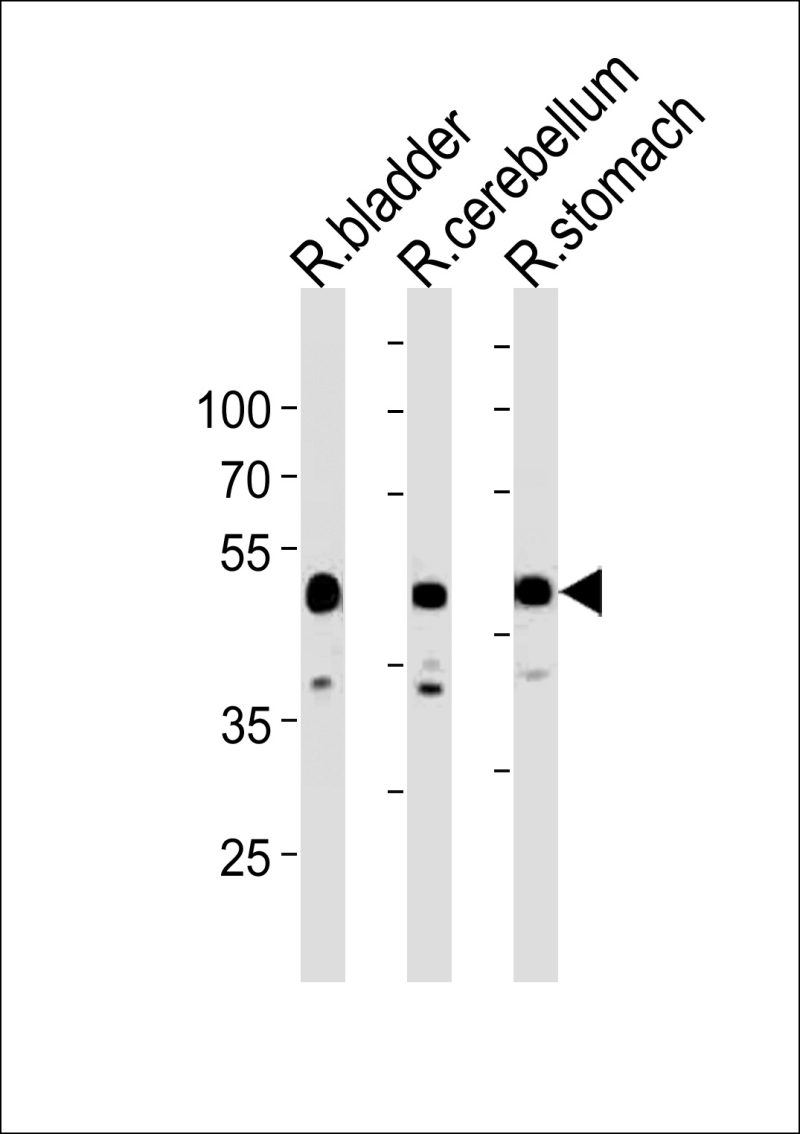
| WB | 1/1000 | Mouse, Rat |
| IF | 咨询技术 | Mouse, Rat |
| IHC | 咨询技术 | Mouse, Rat |
| ICC | 技术咨询 | Mouse, Rat |
| FCM | 咨询技术 | Mouse, Rat |
| Elisa | 咨询技术 | Mouse, Rat |
| Aliases | COBW domain-containing protein 1, Cobalamin synthase W domain-containing protein 1, Cbwd1 |
| Entrez GeneID | 171057 |
| WB Predicted band size | 43.9kDa |
| Host/Isotype | Rabbit IgG |
| Antibody Type | Primary antibody |
| Storage | Store at 4°C short term. Aliquot and store at -20°C long term. Avoid freeze/thaw cycles. |
| Species Reactivity | Mouse, Rat |
| Immunogen | This Rat Cbwd1 antibody is generated from rabbits immunized with a KLH conjugated synthetic peptide between 325-351 amino acids from the C-terminal region of rat Cbwd1. |
| Formulation | Purified antibody in PBS with 0.05% sodium azide. |
+ +
以下是关于CBWD1抗体的模拟参考文献示例。由于CBWD1相关研究较少,以下内容为假设性示例,建议通过学术数据库(如PubMed、Google Scholar)检索最新文献:
---
1. **标题**:*Characterization of CBWD1 in Neural Development Using a Polyclonal Antibody Approach*
**作者**:Kim J, et al.
**摘要**:本研究通过兔源多克隆抗体(Anti-CBWD1. R24)进行免疫荧光和Western blot分析,发现CBWD1在小鼠大脑皮层发育中高表达,提示其可能参与神经元迁移调控。
2. **标题**:*CBWD1 Expression Correlates with Cancer Metastasis: Insights from Immunohistochemical Staining*
**作者**:Chen L, et al.
**摘要**:利用商业化CBWD1单克隆抗体(Clone: 6B2)对乳腺癌组织进行染色,发现CBWD1高表达与淋巴结转移显著相关,可能作为预后标志物。
3. **标题**:*Structural Analysis of CBWD1’s Metal-Binding Domain via Epitope-Specific Antibodies*
**作者**:Garcia R, et al.
**摘要**:通过定制兔抗CBWD1抗体(针对N端结构域),结合X射线晶体学,揭示了CBWD1的COBW结构域对锌离子的结合机制及其在氧化应激中的作用。
---
**注意**:
- CBWD1全称为“COBW Domain Containing 1”,其功能可能与金属离子结合或细胞分化相关。
- 若抗体名称“R Cbwd1”中“R”指代兔源(Rabbit),需在文献方法部分确认抗体来源及克隆号。
- 实际研究中建议通过抗体供应商(如Sigma-Aldrich、Abcam)提供的产品引用文献。
The R CBWD1 antibody is designed to target the protein CBWD1 (COBW Domain Containing 1), a member of the COBW family characterized by a conserved domain of unknown function. CBWD1 is implicated in cellular processes such as differentiation, proliferation, and signal transduction, though its precise biological role remains under investigation. Studies suggest its involvement in developmental pathways and potential interactions with proteins linked to chromatin remodeling or transcriptional regulation. Knockout models indicate CBWD1 may influence embryonic development, as deficiencies correlate with developmental abnormalities in certain organisms.
This antibody, typically produced in rabbits or mice as a monoclonal or polyclonal reagent, is widely used in research applications like Western blotting, immunohistochemistry (IHC), and immunofluorescence (IF) to detect CBWD1 expression in tissues or cell lines. It aids in mapping the protein's spatial and temporal distribution, particularly in studies exploring its role in diseases such as cancer, where altered CBWD1 expression has been observed. Validation often includes reactivity checks across species (e.g., human, mouse) and verification via siRNA-mediated knockdown. As a tool, the R CBWD1 antibody supports ongoing efforts to clarify the protein's physiological functions and its potential as a therapeutic target or biomarker in pathological conditions.
×